My credit card was recently stolen. I used it at a very friendly but technically non-savvy local business. Within a few days fraudulent charges came pouring in, ranging from $1.00 to $401.67. The merchants were Paypal and Amazon. I know I didn’t make these charges but honestly, I don’t care. None of these fake charges was able to touch my money. I have the ultimate credit card security: Privacy.com.
This article contains affiliate links. When you sign up for Privacy.com using the links in this article, both you and I receive a $5 commission. If you do not want to use an affiliate link, simply type in the URL.
I didn’t care about the stolen credit card number because it was a virtual credit card operated by Privacy.com. Privacy.com places a number of limits on cards, giving you maximum security and maximum control over your money. I’ve mentioned it before but I’ve never really gone in the weeds. Today I will.
Before we get into how it works, I will talk about how it benefits you. There are so many benefits it’s honestly hard to know where to start.
No More Stolen Card Numbers: Merchant Locking
The biggest benefit of using the service is that you no longer have to worry about stolen credit card numbers, at least online. Privacy.com requires that you create a new credit card for every merchant. That might sound onerous but it’s not – there are Firefox and Chrome add-ons, and iPhone and Android apps that manage these virtual credit cards for you. This requirement comes with a huge benefit, it’s reason for being. Once a card is billed by a merchant it can only ever be billed by that merchant in the future.
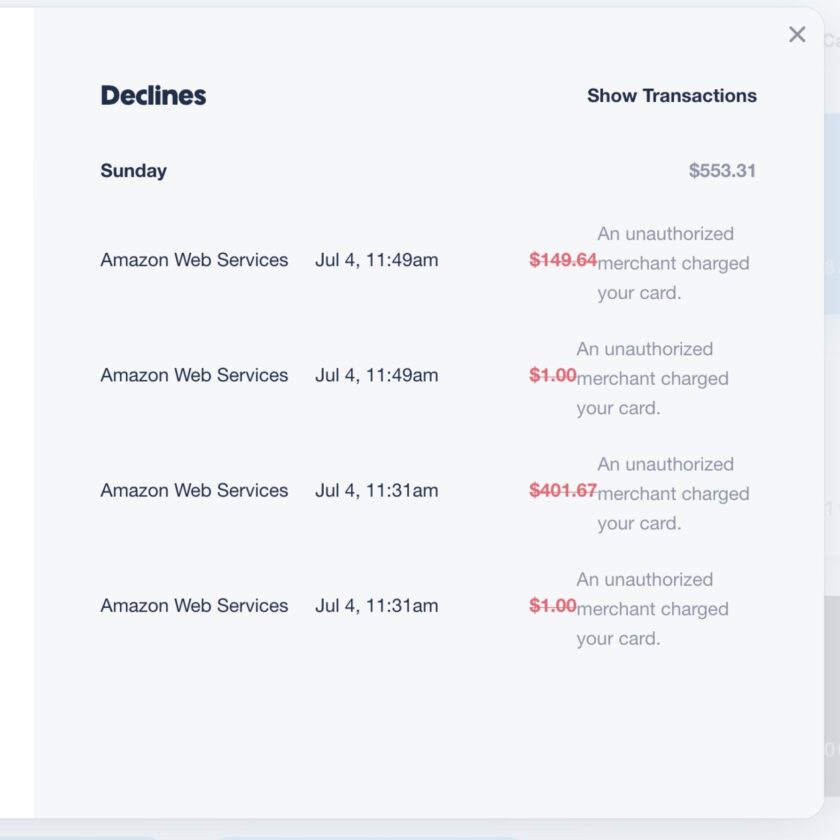
Here is an example of why that is important. You make a credit card for use with your cable company. Cable company gets hacked, credit card numbers get spilled, customers cards are used fraudulently. You aren’t worried at all because you know the only entity that can make a charge to your card is the cable company. Any other charge will instantly be declined. This feature saved me this week.
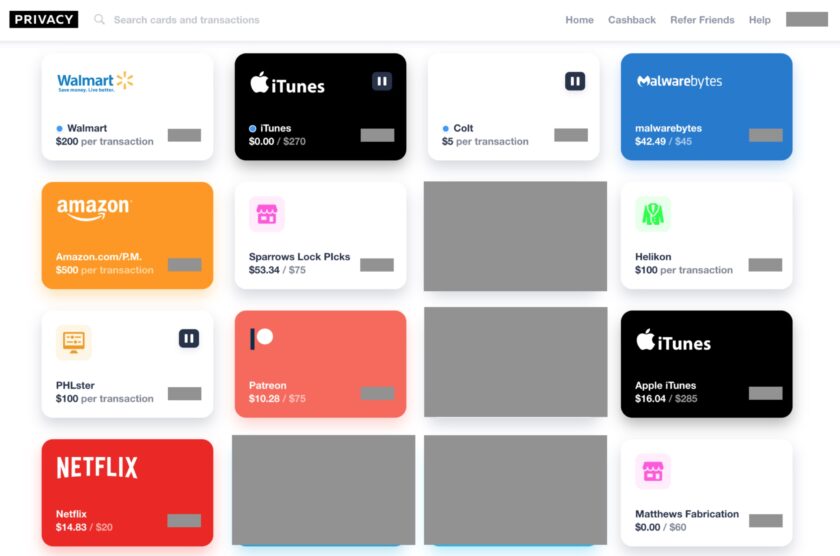
There’s another benefit here. I know my credit card has been stolen, but I don’t care. I don’t have to cancel my card and order a new one. Nor do I have to update my credit card with dozens of services. I do not have the clean up the mess that results from a company’s irresponsible handling of my data. This breach only impacts this one card.
No More Overcharges: Spend Limits
I’m sure we’ve all signed up for something only to realize there were a ton of hidden charges. No more. When you use a Privacy card you set hard spending limits. Any charge exceeding your set limits will be declined. These limits are very flexible, allowing you to customize a card for its intended purpose. Here are some of the options:
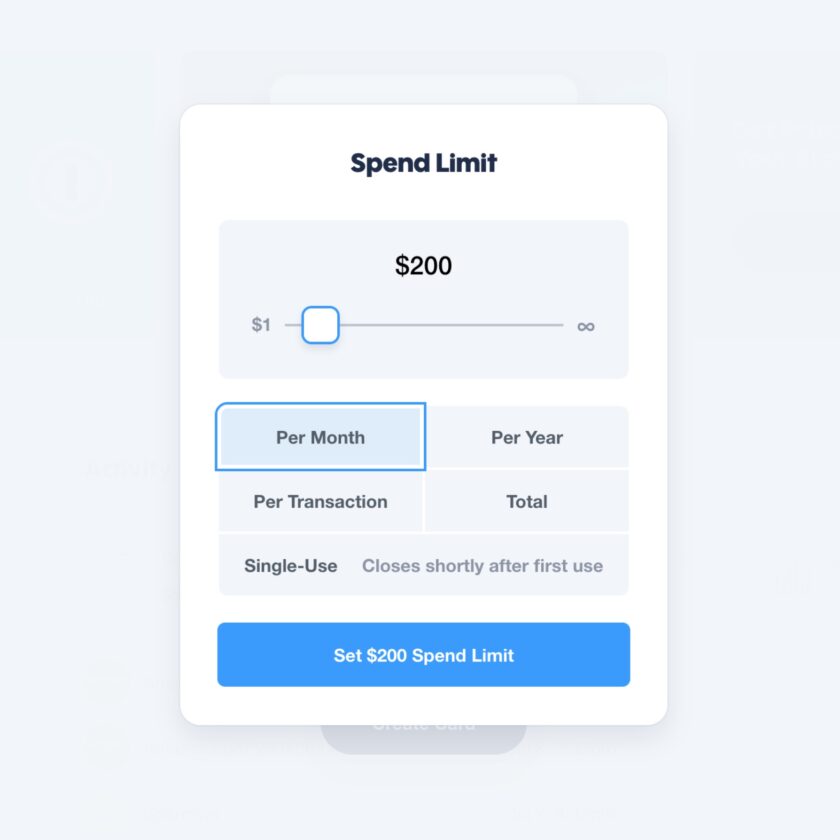
Per Month Spend Limits
I most commonly use “per month” limits for recurring payments like my electric bill, cable bill, and phone bill. Each has monthly limit just slightly higher than my estimated monthly cost. If the electric company accidentally double-charges me the transaction is declined. They have to demonstrate to me why I owe them extra. I no longer have to prove to them why they need to give my my money back.
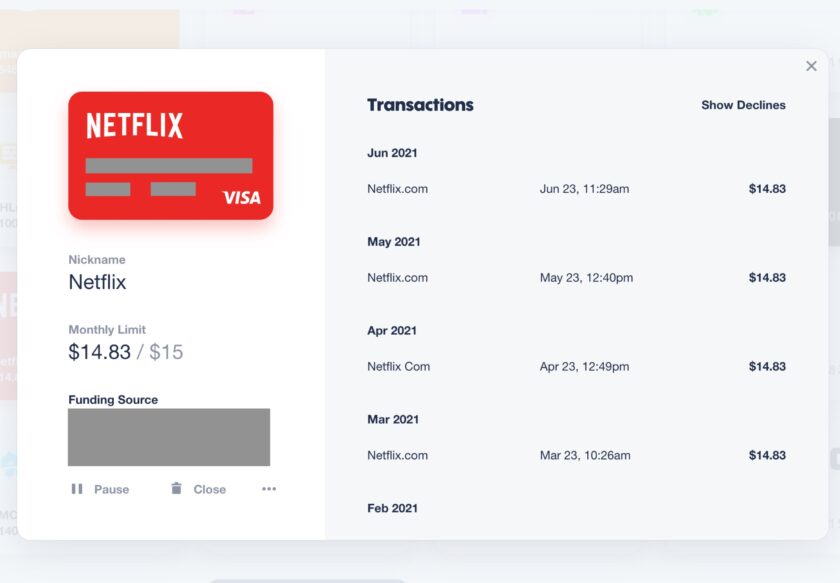
Per Year Spend Limits
This setting is useful for things like your car insurance, annual club memberships, or yearly subscriptions. Even though it is billed semi-annually, I know the annual total of my car insurance I set a “per year” limit and forget about about it.I also know that if I join a hiking club or professional membership, the annual membership fee is the only time my card should be billed. I set the limit to just a dollar or two over the total cost. If the club attempts to bill for some something extra the charge will be declined, allowing me to decide if I want to spend that money.
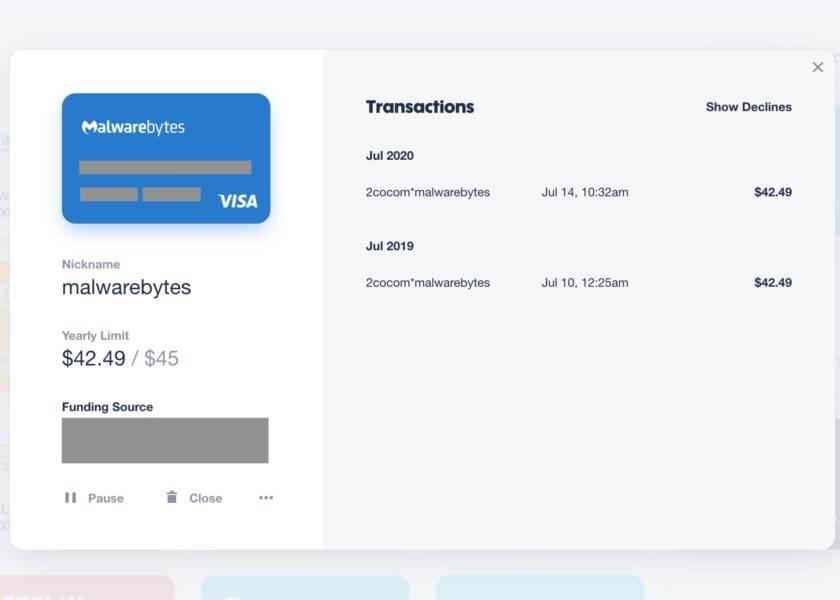
When signing up for subscriptions I often set a per-year limit. Things like antivirus, VPNs, software, etc. often bill on an annual basis. I set the total cost as my “per year” limit. Now the antivirus company can’t upsell me on additional products or a “more premium” offering without my permission.
Per Transaction Spend Limits
I generally use this when making a one-off purchase. Recently I purchased a PHLster holster. I doubt I will be purchasing another soon, so I set the limit as “per transaction” and made the amount just over the total purchase price. Maybe I’ll order another in the future, but it’s certainly not going to be a regular, recurring charge.
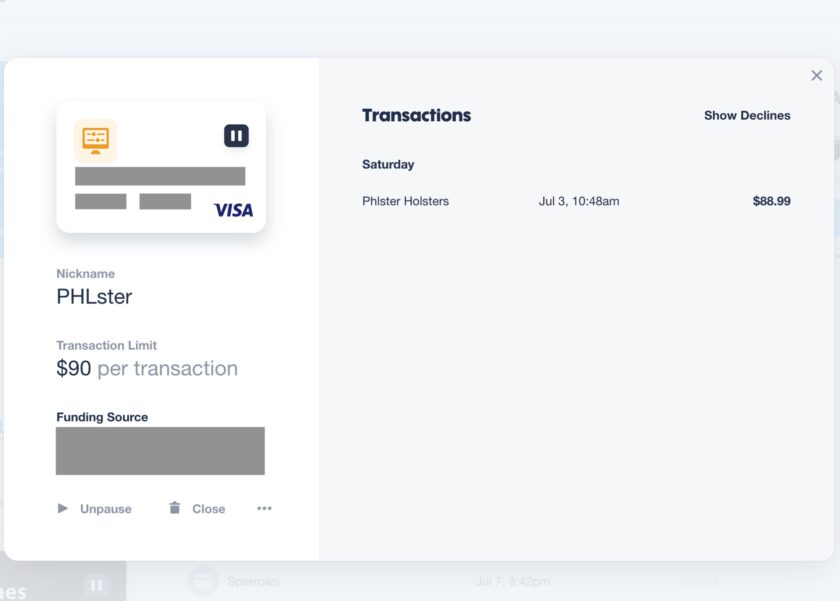
Single-Use Spend Limits
I use this option only rarely. This means that you can only make one charge with the card, and then it will be closed. I use “single use” when I know I will not make more than one transaction with a merchant. For instance, when ordering take-out while staying in a hotel. I probably won’t ever order from that restaurant again. I certainly don’t want to give the person on the other end of the line my name, home address, and real credit card info. The screenshot below illustrates this.
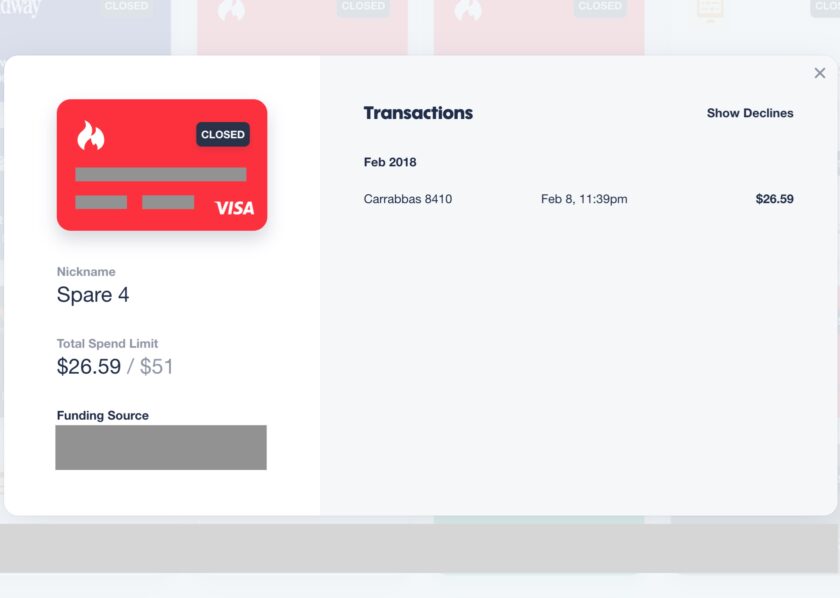
I don’t only limit this to small transactions. I used Privacy.com with a “single use” limit to purchase a gun safe. Honestly, I’m probably not going to make an order through GunSafes.com again anytime soon. I don’t need to create a card that can be used multiple times.
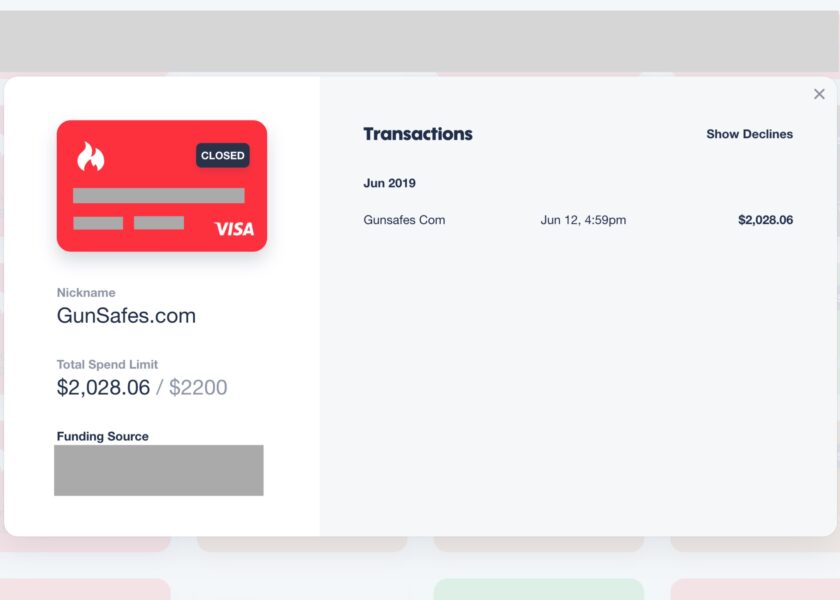
Changing Limits
If you discover a limit doesn’t work for you you can easily change it. You can raise or lower the dollar limit with a simple slider. You can also change the type of limit. The only limit you cannot change is “single use” after a charge has been made to the card.
No More Recurring Charges
Privacy.com is amazing at preventing unwanted recurring charges. How many of use have signed up for a website, a gym membership, whatever, only to have it fall into disuse, yet continually charge us for months? Then once you discover the charge you have to track down your login credentials and figure out how to cancel. There is an easier way.
Controlling Recurring Charges
If you only want a single unit of whatever it is (i.e. a single month of a subscription) simply make the card a “single use” card. It will pay for the first month, then close, disallowing any future charges. If you only want a trial of a website simply set the dollar limit high enough to cover the trial, but lower than the cost of the full subscription. You aren’t stealing anything; you’re paying for the trial, yet preventing being charged for services beyond what you desire.
There is still one more feature of Privacy.com that ensures your cards will only be charged when you permit them to.
Pausing Cards
You have the ability to “pause” a card. While paused no charges can be made against a card. There are many ways to use this feature. If there is a card I use only occasionally, I keep it paused when not in use. For instance, my Privacy.com cards for hotels, airlines, online ammo ordering, my archery supply website, and fitness supply company are all paused. I will use them again so I don’t want to make them “single use,” but I don’t want them open and available at all times.
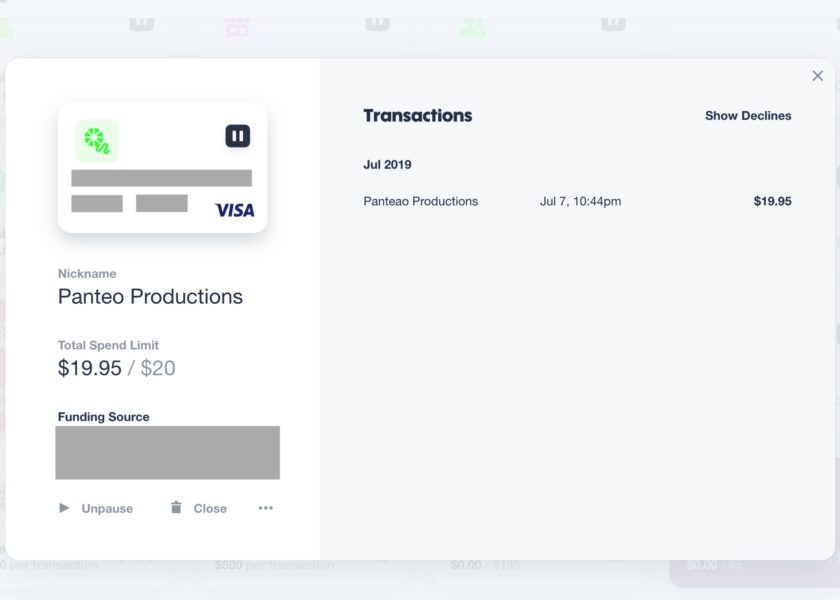
Here is another example of a paused card. I signed up for a subscription with Panteao Productions, a company providing online firearms training. There were only a few videos on 1911 maintenance that I wanted to see. I was willing to pay for a one-month subscription to watch these videos, but did not desire to be charged for more than that. The photo above shows the initial charge successfully processing.
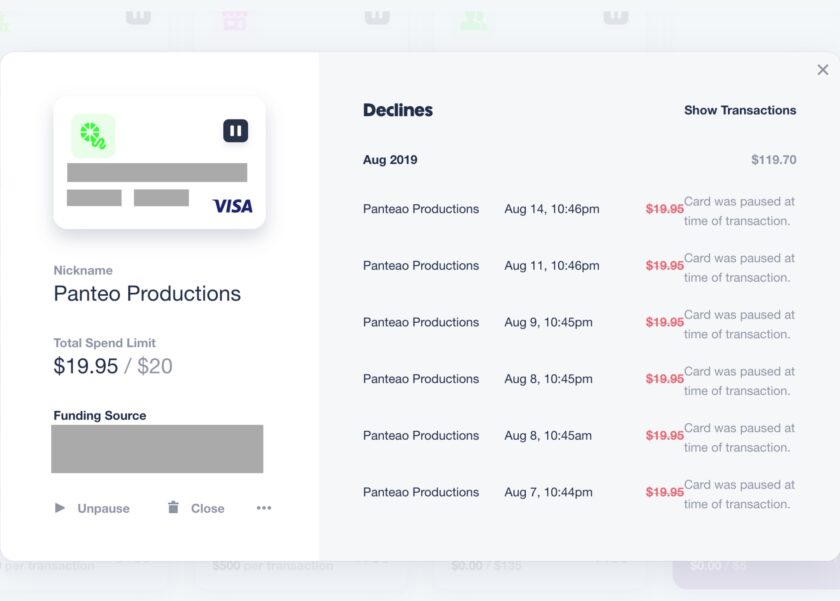
As soon as it was processed I paused the card. This guaranteed that I could not be charged more than I wanted to be charged. The photo above shows the attempted charges to rebill me. This isn’t unethical behavior on Panteao’s part, mind you. It’s just easier for me to stop payment than it is for me to cancel, then get bombarded with emails begging me to come back.
In this instance had I forgotten the pause the card the “total spend limit” would have still saved me from unwanted charges. There are a number of redundancies built into Privacy.com to prevent your money from being taken without your express permission.
The “Privacy” Part of Privacy.com
So far I have only focused on the security benefits of this service. Honestly, it is a pretty impressive suite of security benefits. But there are also some pretty big privacy benefits.
Before we get into these let’s talk about what Privacy.com is not. It is not bulletproof protection from the government. It won’t make you “invisible.” It won’t hide you if you commit crimes. But it is a nice layer of privacy over your purchases. Here’s a good “for instance” – buying ammo online.
Up until the price surge in March 2020 I purchased quite a bit of ammo online. Every payday I’d order a couple thousand rounds. Now, I really don’t want my bank knowing I’m buying ammo in those quantities. Not that there’s anything wrong with it, it’s just none of their business. So, I used a Privacy.com card instead. All the bank sees is a couple hundred bucks going to Privacy.com, not whatever online merchant I’m using. Why do I care about that? You probably don’t realize it but your bank sells information about you and your spending habits. I don’t really care for that sort of behavior.
And to tell the truth, I want to protect my identity from the companies I purchase ammo from. Not that I distrust them, but the less information they have the better. Nothing against merchants, but they went into the retail business, NOT the computer security industry. The less information they have, the less information they could be compelled to hand over by an increasingly overreaching government.
Privacy.com sort of functions as a trusted middleman. They are an entity that I trust to protect my privacy to the fullest allowable by law. I don’t trust the bank, and in most cases I don’t really trust merchants. Again, it’s not perfect protection, but it is something. Now, let’s get into how this stuff works.
How Privacy.com Works
At this point you maybe wondering how Privacy.com works. In a nutshell you create an account and associate a bank account (or two, or three). When you want to make a virtual credit card you login and do it, or do it via the mobile app or Chrome/Firefox add-on. When you are ready to make a transaction give the virtual credit card number. Privacy will then withdraw money from your account and forward it along to the merchant. Until you make a purchase not a dime from your account is touched. Simple as that.
Using the service is very simple, but setup can be a bit intimidating. Here’s how it works.
1. Create an Account
Go to Privacy.com and create an account. It only takes a few minutes. This will involve providing some biographical information and an email address. I strongly recommend using a very strong passphrase and two-factor authentication on your account (remember, it touches your finances). Since Privacy.com is accountable to anti-terrorism and banking/finance laws like AML and KYC (Anti-Money Laundering and Know Your Customer, respectively) they sometimes require that you provide ID. I believe this hoop is well worth jumping through.
2. Provide a Funding Source
Next you will need to provide your account with a funding source. This is a banking account (checking or, I believe, savings). This is where things can get a little scary. You have to give Privacy.com access to your bank account. This may seem counterintuitive, but consider this: would you want them to be able to withdraw money from your account if you didn’t give them access? And Privacy is on the up-and-up. I trust them with my bank accounts. At this point you may have to wait from a few minutes to a couple days for your bank account details to be verified.
You can add multiple funding sources. I have two. The first is my personal bank account. The other is a business account. You will notice that in the screenshots I have greyed out the funding source (you guys don’t need to know where I bank, after all). When creating a new card you can choose between your various funding sources.
3. Create A Virtual Card
Once your account is setup and verified, begin making and using virtual cards. You can do this multiple ways: through your online account, via the Chrome/Firefox add-on, or within the Android/iOS mobile app. The process is dead simple. Since I use the web login (which incidentally is the most difficult) I will walk your through that.
Click “New Card.” The new card interface will pop up.
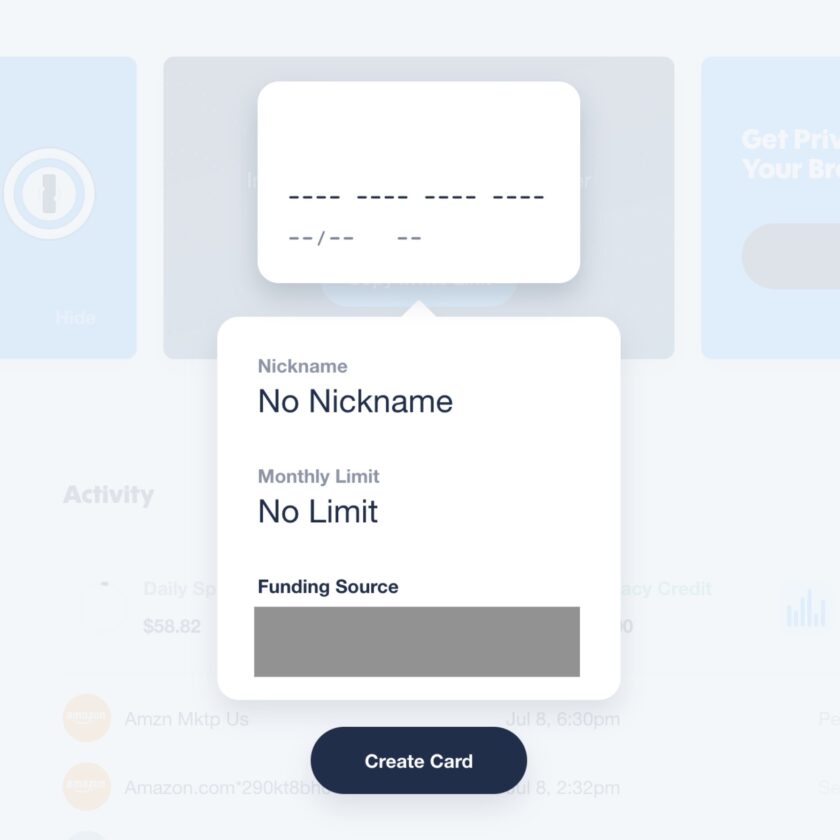
Give the card a nickname. You can call it anything you want. You can title it “Walmart” and use it at Amazon if you like. This is merely to help you organize your cards. I give them a name that is purely organizational.
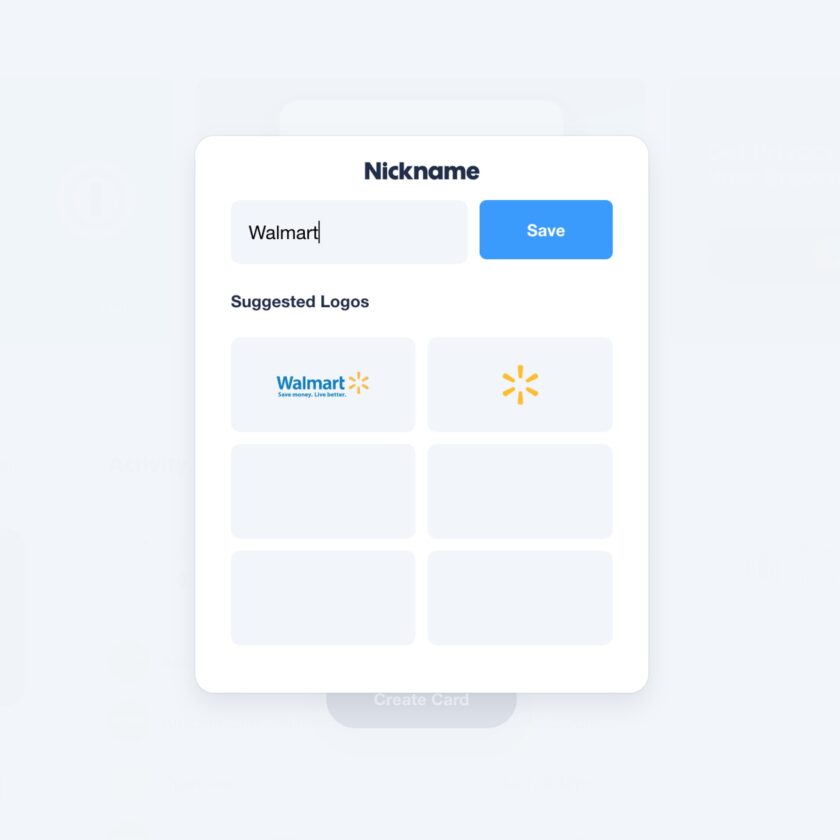
Assign the Spend Limit parameters in both dollar amount and limit type. Also, choose your funding source if you have more than one.
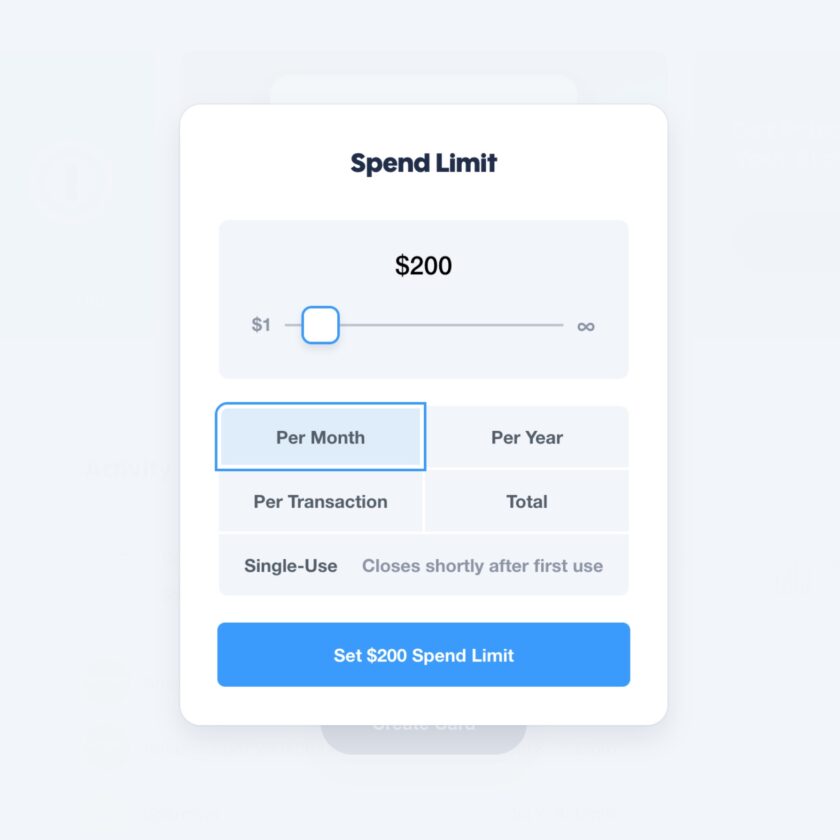
Finally, hit “create card.” You are now ready to use it.
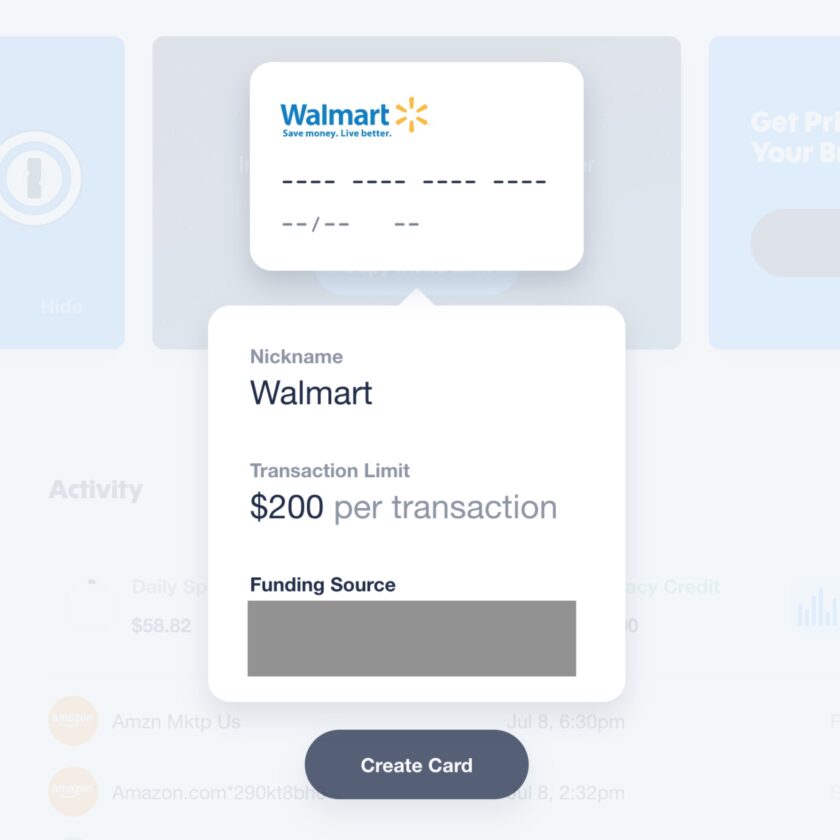
The card will be generated and you will be provided with a 16-digit card number, an expiration date, and a CCV security code.

Now you are ready to use the card.
Using Virtual Cards
You can use virtual cards just like regular cards…with one limitation: you can’t use them in person. This is because you don’t get an actual physical card, just the relevant numbers. When you get to the checkout screen, enter your virtual credit card number, expiration date, and CCV. When prompted to enter your name, billing address, and shipping address, you can use anything you like. This is great for stuff like ordering pizza at hotels. I don’t want to give the pizza guy my real home address…so I use the hotel’s address as the billing address. As long as the money is in your account and the card isn’t banned for some reason (like being used elsewhere or being over spend limits) the transaction will be approved.
Frequently Asked Questions About Privacy.com
Do YOU Use Privacy.com?
That’s a more than fair question. The answer is an enthusiastic YES! All of the screenshots in this article are from my actual account. I have been using Privacy.com for about five years. I don’t remember the exact date I started using it but once I saw its potential I was immediately on board. After a couple of months of learning it I dove in head-first and set all my bills up on Privacy.com cards. Currently I have over 100 active Privacy.com cards. I know that ever single time I give out my credit card online I am rolling the dice. Using Privacy.com I no longer care.
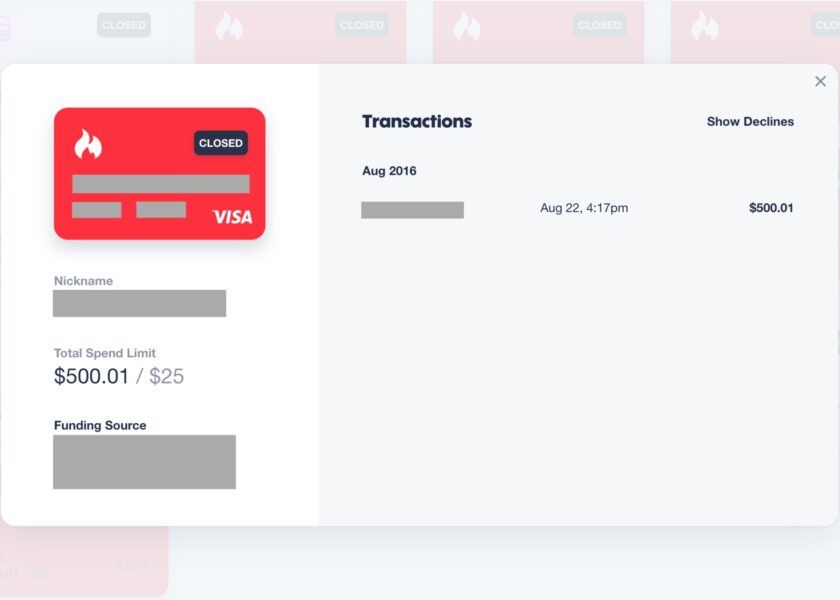
The card above is the oldest one I could find. I’m sure the are older charges than this one – some of my very old cards are likely still active.
How is Privacy.com Free?
By now, savvy readers are wondering, “how is this service free?” Privacy.com must be making money somehow, right? If they aren’t charging you… Admittedly it doesn’t look good. Fortunately I know exactly how they turn a profit.Pay With Privacy/Privacy.com makes money off the transaction between the bank and the merchant. They make about 3 cents on every transaction. It doesn’t cost you anything more – that is usually charged to whoever the processor is, anyway. This means Privacy.com is free to you but they have a solid monetization model. Selling your data is not part of that model.
Privacy.com also recently added some paid tiers. Personal is free, but limits the number of cards you can create to 12 per month.
What About Refunds?
I frequently get asked what happens if you send something back and get a refund. Long story short: the exact same thing that happens with any other card. The money is released back to Privacy.com, who deposits it back in your bank account. I’ve used this service long enough and extensively enough that I’ve had this happen plenty of times. The photo below illustrates refunds.
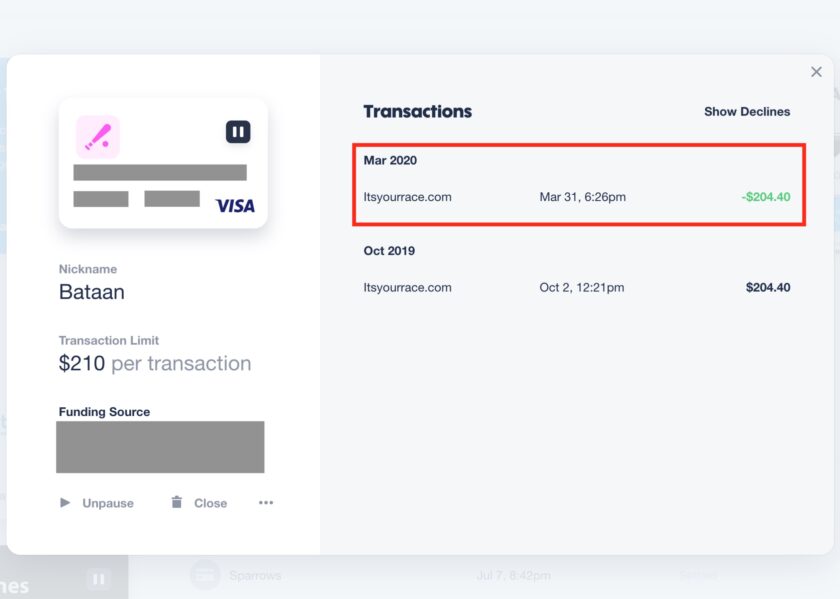
My girlfriend and I signed up for the Bataan Memorial Death March for 2020. Obviously shit happened in 2020 and we didn’t go. But we did get refunded. Even though this card was pause the money came back and went into my account.
Are There Transaction Limits?
Yes, there are transaction limits. Initially they are quite low, somewhere around $250 for an individual transaction and maybe $1,000/month. You can find out for sure by going into your account details. This will grow with time. I don’t know their algorithm exactly but I have heard directly from the founder’s mouth that transaction limits go up with use. Requiring you use the service for some smaller purchases and sticking around over time is part of their fraud prevention effort. The fastest way to get limits raised – again, from the founder’s mouth – is to set up a recurring monthly charge or two, like your phone bill and a utility.
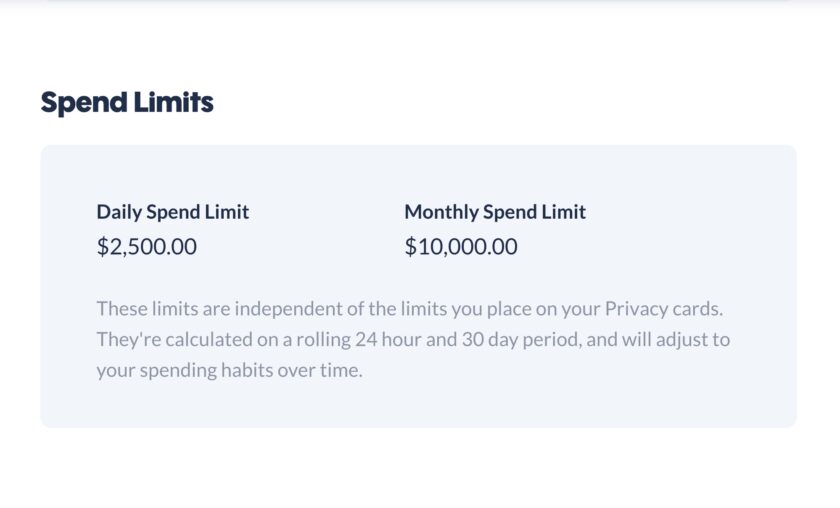
After 5 years of use I have some substantial transaction limits. Still, once in a while I purchase something that exceeds the normal limits, like my laptop. In these cases I have simply reached out to Privacy.com and asked for a temporary limit increase. They have been happy to help me out.
What About Credit Card Points?
Short story: you don’t get any. At least not with the free, Personal-level account. With the paid, $10/month account you get up to 1% cash back on purchases up to $4,500/month. That probably doesn’t compete with the best credit cards. Personally, though, credit card theft/fraud is a thing I have just stopped worrying about. That is well worth trading for the small sum I would receive in “points.”
Can I Fund a Privacy Account with a Credit Card?
Again, short story: no. You have to fund Privacy.com with a bank account. You also have to have the money in your account to cover whatever charges you incur.
Closing Thoughts
Privacy.com is probably the most important service you’ve never heard of. And it’s not just for privacy nuts enthusiasts. If you care about protecting your finances and preserving a little bit of your privacy you should look into Privacy.com. I understand it can be a bit daunting at first. I hope this article has made it somewhat understandable and approachable. If not, let me know and I’ll try again!







1 thought on “Eliminate Online Credit Card Theft with Privacy.com”
Comments are closed.